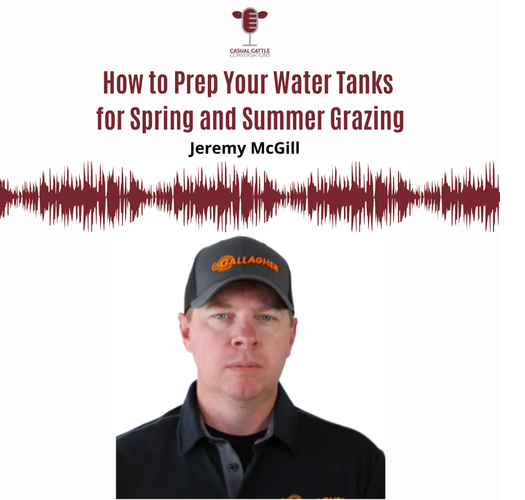The Casual Cattle Conversations Podcast: How to Prep Your Water Tanks for Spring & Summer Grazing
Tuesday, February 28, 2023
Reference: Podcast Corner

How to Prep Your Water Tanks for Spring & Summer Grazing
Feb 27 | Written By Shaye Koester
Think spring. Think spring. Think spring. At least that is what I am trying to do! I am not sure about the rest of you but for those of us up north are ready for winter to be done and to see some green grass and sunshine. All that green grass and sunshine will bring on spring and summer grazing and who doesn’t want to see their cattle out on pastures? With grazing comes the need for providing water sources for your cattle. Providing water for your herd looks different depending on your grazing system, but there are a few things all producers need to know. Jeremy McGill joins the podcast to share his experiences with both permanent and temporary watering systems for grazing strategies. Jeremy discusses tank location, maintenance and how to fence off natural waterways for cattle and wildlife in this podcast episode.Click Here to listen to Shaye's Podcast
Tank Location
Water is the limiting factor for producers utilizing rotational grazing. McGill reminds producers to utilize the 800-foot rule when it comes to placing water tanks. The purpose behind the 800-foot rule is to avoid livestock coming to drink in large groups. When animals are within 800 feet of the water tank, they are more likely to come up in smaller groups and reduce the need for larger tanks or the risk of tanks not keeping up with the amount of livestock drinking. The second part of the 800-foot rule relates to nutrient distribution. Nutrients are distributed more evenly across pastures when cattle are within 800 feet of the water source.McGill is open about the fact that rotational grazing and placement of permanent water systems was quite the learning curve for him and his wife during the first few years. Adjusting paddock size, shape and location along with the location of water tanks is just a part of the process. He recommends using temporary pipe systems and your current permanent tanks to learn what works and what doesn’t work before investing in permanent water systems.
Infrastructure Cost & Maintenance
The type of tank you put in is dependent upon your location, terrain and the number of cattle that are relying on it to meet their daily water intake requirements. If you are looking at permanent structures, be sure to factor in what type of pressurized system you are using to fill the tanks, the type and length of pipe needed and the placement of a cement slab to mount to when budgeting for the project.Input cost is always an important factor to consider anytime you are making a change in your operation. McGill encourages cattle producers to turn to programs like EQIP or anything similar to help reduce the initial input cost of putting in new watering systems.
Yearly maintenance is an important part of keeping your tanks in working order and ensuring they last longer. McGill reminds producers to drain tanks and clean out any debris that was brought in by cattle. This is also an opportunity to check your valve systems and seals to ensure they are in working order and perform any updates if needed.
Fencing Off Waterways
Natural waterways can be used as water sources for cattle, but it is important to remember that fish and wildlife are also relying on these same water sources. McGill describes a simple fencing system to allow cattle to drink from natural waterways but also limit their access to the entire system. This looks like fencing off both sides of the bank, finding a heavy-use area, and creating a water gap that allows cattle to enter the stream, drink and then immediately leave.At the end of the day, your watering system is going to be unique to your operation. Come into it with an open mind and willingness to learn and try new methods. Just keep in mind the basics of how far cattle will have to travel to their water source, how many head are using a singular source and how wildlife will be impacted too. Once again, think spring and keep on keepin’ on.
Sign up to stay connected
- News
- Property Alerts
- Save your favourite properties
- And more!
Joining Farm Marketer is free, easy and you can opt out at any time.

